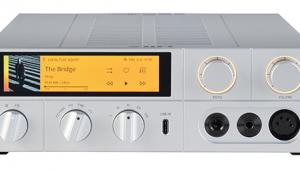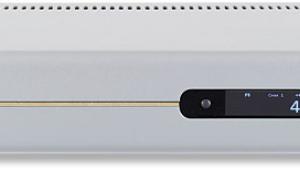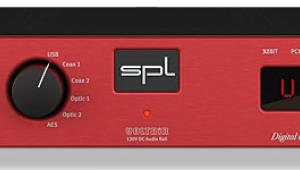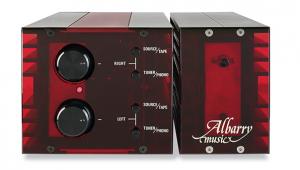Weiss Minerva (£3000)
As the tone of my reviews of the Linn Majik DS and dCS Scarlatti Upsampler/DAC may have hinted, I am beginning to see hard disk – rather than optical disc – as my audio source of choice in the near future. If you have been thinking along similar lines, your mind may have boggled at all the different ways of achieving this.
A single-box music server solution is not for me, if only because for review purposes I’m likely to require a component rather than integrated solution. And streaming players are out because I insist on having multichannel capability. USB-connected DACs fall by the wayside for the same reason and because I have to be able to play 176.4/192kHz files, which no USB device I know of supports (most are limited to a paltry 48kHz). So increasingly my attention has been turning to FireWire-connectable DACs – a pretty common breed in pro audio applications but something of a rarity in the audiophile market.
WEISS SQUAD
One notable exception is the Weiss Minerva, which is a prettied-up audiophile incarnation of the company’s professional DAC2. Internally and in respect of capabilities and interfaces the two are identical, but the Minerva looks less utilitarian to suit domestic surroundings better. Although it is a two-channel device, multiple Minervas can be daisy-chained via the FireWire interface, allowing you, in theory at least, to build a multichannel system. But Daniel Weiss tells me he hasn’t tried this, so if you plan expansion along these lines you should assure yourself first that Minervas can indeed be used this way without latency or other issues.
Weiss provides drivers and control software for Windows XP SP1 and SP2 (32- and 64-bit versions), the original 32-bit release of Vista (64-bit and SP1 versions are in beta test) and Mac OS X. As the Minerva takes no power from the FireWire interface, it is compatible with both 4-pin and 6-pin FireWire 400 outputs (the connectors on its own back panel are 6-pin). Unfortunately, compatibility is not guaranteed: our sample worked fine via my laptop but refused to function correctly with the Belkin F5U508ea FireWire/USB PCI card I’d bought for the (measurement) PC that resides in my listening room. Replacing it with an HP Adaptec FireConnect 2100 fixed the problem.
While it’s the Minerva’s FireWire interface that particularly interests me, this isn’t the only way to get signals into and out of it. As well as providing balanced and unbalanced analogue outputs (on XLR and phono respectively), the rear panel offers S/PDIF digital inputs on RCA and Toslink, AES/EBU digital input on XLR and digital outputs on both RCA and XLR. The electrical digital connections are all compatible with the single-wire 192kHz AES3 standard or, via an internal jumper, the Minerva can be configured for 192kHz twin-wire operation instead, in which case one channel is carried on the RCA connector and the other on the XLR.
All this allows the Minerva to perform the following conversions: FireWire to analogue, S/PDIF or AES/EBU to analogue, S/PDIF or AES/EBU to FireWire, and FireWire to AES/EBU or S/PDIF – although if you only want the latter two digital conversions you’d save money buying the Weiss Vesta instead.
HEAD 'N' HEART
Getting the best out of the Minerva, or any other audio device for that matter, when using Windows XP requires bypassing the operating system’s Kernel Mixer. This is easily achieved using either the Kernel Streaming or ASIO plug-ins for the Foobar 2000 player, both of which work seamlessly with the Minerva and give bit-accurate audio from its S/PDIF output. This is not a statement of blind faith, as it so often is in computer audio forums: I know because I tested its 24-bit resolution and various sampling rates. Compared to the DirectSound output, which is routed through KMixer, either KS or ASIO deliver clearly superior sound quality, obviating the fuzzing that occurs via DS.
With this important proviso, the Minerva delivers sound quality of the first rank. It has the happy knack of combining a high level of transparency with a seductive but utterly natural tonal warmth, thereby pleasing both the head and the heart.
MUSIC FIRST
Two examples. Sinatra At The Sands on DVD-A is a bit of a fraud, at least as far as its 24/192 stereo track goes. Spectrum analyse it and you find that, far from being a true 24/192 transfer from the master tape, it has been upsampled, badly, at least once, perhaps twice. So it is no audiophile exemplar. But Sinatra is in fine voice and he and Count Basie’s band are well captured. I have rarely, if ever, heard ‘I’ve Got A Crush On You’ sound fresher or more vibrant than it did via the Minerva.
Meanwhile, Linn Records’ 24/88.2 Studio Master download of Mendelssohn’s Hebrides Overture, performed by the Scottish Chamber Orchestra, can sound a little lacklustre, particularly in direct comparison with the same label and band’s Mozart Serenades, recorded in a lively church acoustic rather than Usher Hall. But persevere and, if your system has sufficient resolution, you’ll begin to appreciate this recording for the understated nature of its fidelity: it picks you up and carries you along.
The Minerva’s enviable combination of warmth and transparency again cut through to the heart of the music making here, conjuring up a listening experience that was informative without being over-etched, comfortable without being schmaltzy. Excellent hi-fi – but even better music.
VERDICT
Short of dCS territory, this is about as good as computer audio currently gets. The Minerva may be a tad on the expensive side but the fact that it offers excellent sound quality, playback capability up to 24/192 and at least the potential for expansion to multichannel makes it a big fish in what is currently a small audiophile pond. Highly recommended.
Originally published in the April 2009 issue



















































